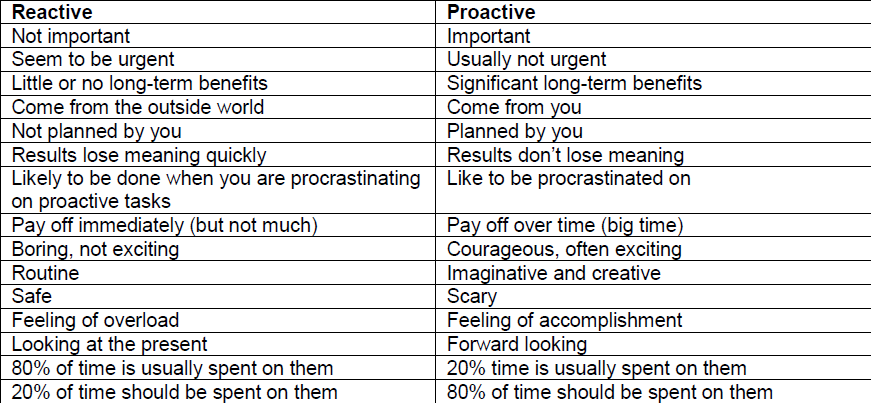Developing self-awareness is an important step in starting to take control of our reactive patterns. After all, without self-awareness our reactive patterns have full reign to continue as before. If we want to be able to respond instead of react we need to be able to see ourselves clearly.
In fact, get the thinking in. It might be interesting to just review your behavioral patterns and create an overview that identifies how often you behave proactive and reactive (so how often do you think before responding and how often do you just respond).
Now, have a look at your overview and mark the ones that don’t feel good to you and try to find out why they don’t feel good. This is the first step of creating self-awareness and creating openings for a different approach.
Reactive and proactive behavior have common characteristics, but different perspectives:

Perhaps that spending time strictly on proactive tasks is the holy grail of personal achievement, but it is not attainable for the most of us. However, spending 80% time on proactive tasks and just 20% of time on reactive tasks is a realistic goal that everyone can achieve. Once you achieve this balance, your life will be forever different – in the best possible way.
You will be moving in the right direction, every day, every week, building your better life step by step. The results will stick and every day will be better than the last one. Sure, there will be some ups and downs, but the general trend will be unquestionable. You will slowly become your own boss.
Self-application
- Go through your ‘To-do list’ and count all reactive tasks and all proactive tasks (do not count everyday tasks that must be done regardless of the circumstances (e.g. ‘feed the baby’).
- What reactive tasks could you eliminate? – park these on a ‘Never –To-Do-List”
- What reactive tasks could you change into proactive tasks?
- What proactive tasks would you like to add?
- What should the end result of the proactive tasks be to make this successful for you?
- What actions do you need to take to achieve this end result?
Coaching application
Coaching clients might get stuck in their habitual patterns that keep them from becoming more proactive and taking control.
Supporting the client to reflect on their Reactive and Proactive behavior will increase their self-awareness. What’s the client’s balance in reactive and proactive behavior and how does he feel about this, what would he like to change?
An increased self-awareness will then help the client to explore the reasons behind unwanted reactive behavior. Why do I choose to react like this, what’s the reason behind this? Reasons can then be taken as a starting point for coaching e.g.:
Coaching reflection
- How do you apply pro-activeness as a coach in the coaching relationship with your clients?
- How do you manage a situation in your coaching where a client tells you he feels out of control in their life?
- How questions do you use to support the client in creating awareness about reactive vs. proactive behavior?
References:
Book “Coachen als professie”(G.M. van der Pol)
Wikipedia
Book “The Seven habits of highly effective people” (Stephen Covey)
Book “Who moved my cheese” (Spencer Johnson)
Psychotherapy, Life Coaching & Marriage Counselling (Serge Prengel)